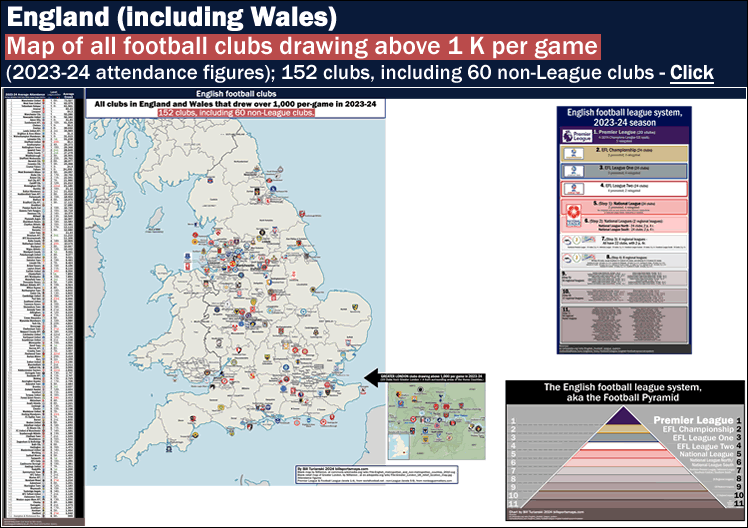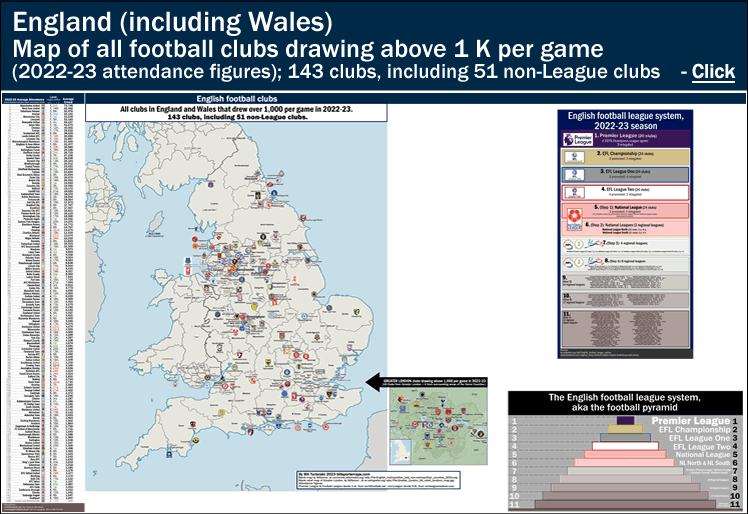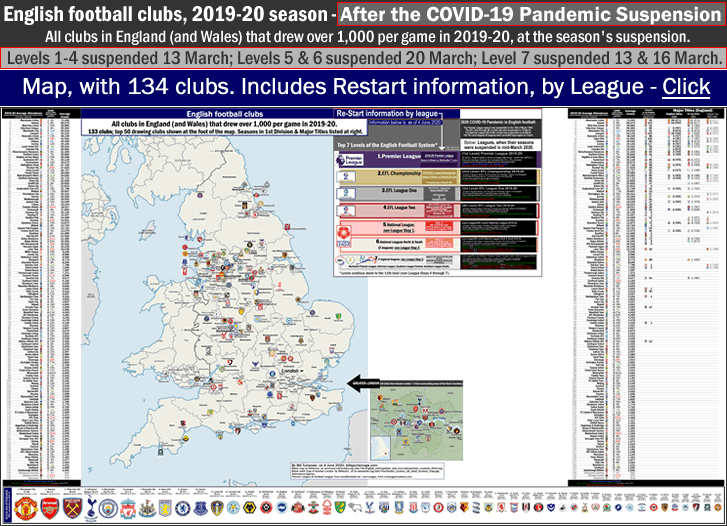
England (including Wales) – Map of all clubs drawing above 1,000 per game (2023-24 attendance figures): 152 clubs
…
…
By Bill Turianski on the 5th of June 2024; twitter.com/billsportsmaps.
Attendance figures…
-us.soccerway.com/national/england/premier-league/20232024/regular-season (Average attendances last season from the 1st division through the 6th level.)
-nonleaguematters.co.uk. (Average attendances last season from the 7th level and further down.)
-(Note: in English football, the last 4 seasons of full attendance have been: 2018-19, 2021-22, 2022-23, and 2023-24. The gap being the two seasons that were COVID-affected: 2019-20 and 2020-21. In non-League football, those 2 COVID-affected seasons break down to the following…2019-20 season: COVID-shortened [up to mid-March 2020] for levels 5 and 6, and fully COVID-abandoned for all non-League levels below the 6th; 2020-21 season: fully COVID-abandoned for all of non-League football [from the 5th level on down].)
-
The map.
The map shows all clubs in the English football system which drew above 1,000 per-game in 2023-24 (home domestic league matches): 152 clubs, including 60 non-League clubs.
Also, there is an inset-map for all the clubs drawing above 1-K-per-game from Greater London-plus-the-immediate surrounding area (19 clubs from Greater London + 4 clubs from surrounding areas of the Home Counties).
On the left-hand side of the map-page, the clubs are listed by average attendance, along with a column showing 4 things:
A) 2023-24 League-level;
B) 2023-24 league-finish;
C) Champions League Group Stage qualification [for the top 4 teams in the Premier League (text in blue)];
D) promotion-or-relegation, if applicable (text in green for promotion / text in red for relegation).
On the right-hand side of the map-page are 2 charts showing the English football league system, aka the Pyramid. {See this, English football league system (en.wikipedia.org).}
I included Hampton & Richmond Borough (who drew 999 per-game), because there are almost always slight discrepancies in attendance figures from source to source, especially in non-League football, and 999 per-game is just too close to one thousand to leave them off the map.
When I first made this map, it was five years ago, for the 2018-19 season. Then, the map showed 133 clubs, including 41 non-League clubs. So in the space of half a decade, the amount of non-League clubs drawing over one thousand-per-game has increased by 19 (from 41 non-League clubs to 60 non-League clubs). That is but one indication of how non-League football attendance is on the rise.
This season [2023-24], eight of the 152 clubs are clubs which were not drawing above 1-K-per-game in the last four seasons of full attendance… (Chatham Town, Hampton & Richmond Borough, Horsham, Radcliffe, Ramsgate, Tamworth, Warrington Town, Weston-super-Mare AFC).
Of those 8 clubs, only 6th-tier-/-National League North champions Tamworth (of Staffordshire) has drawn above 1,000-per-game previously. (Tamworth, in two spells as a 5th-tier side, drew above 1-K-per-game for 8 seasons [from 2003-04 to 2006-07, and from 2009-10 to 2012-13].). Tamworth returns to the 5th division after an eleven-year absence.
Seven of those 8 clubs, to the best of my knowledge, had never drawn above one thousand per-game before last season. Below, those 7 clubs are profiled.
-Chatham Town FC.

Background pattern above, from: shop.chathamtownfc.co.uk/products/replica-home-shirt-23-24.
Chatham Town FC are from Chatham, in Medway, Kent [in SE England]. Chatham is part of the Medway unitary authority (along with the neighbouring towns of Gillingham, Rochester, Strood, and Rainham). Population of Medway is around 279,000 {2021 figure}. Chatham is located, by road, 34 miles (54 km) SSE of central London. Chatham is a couple miles south-west of Gillingham. Chatham Town wear red-and-white. Chatham Town are nicknamed the Chats, and are a 7th-tier side in the Isthmian League Premier Division. Chatham Town play at the Bauvill Stadium, on Maidstone Road, in Chatham. Seven years ago, in 2017-18, Chatham Town were a 9th-tier side in the Southern Counties East League Premier Division. They had just been relegated out of the Isthmian League (after an eleven-season spell in the 8th tier), and were drawing below 200 per game. In the 2018-19 season, the Chats improved from 16th place to 4th place, and drew 194 per game. In the COVID-abandoned season of 2019-20, Chatham Town ended up in 3rd place and doubled their crowd-size, drawing 405 per game. A year-and-a-half later, when COVID restrictions were cleared for 2021-22, Chatham Town kept drawing larger crowds, and averaged a league-best 658 per game, and they won automatic promotion as 2nd-place finishers. And in 2022-23, back up in the 8th tier, in the Isthmian South East D1, the Chats made it back-to-back promotions, as they won the league by 7 points, and drew a league-best 931 per game. Which is very good for an 8th-tier side. And in the 2023-24 season, Chatham Town, now in the 7th-tier Isthmian Premier League, finished in 2nd place. In the play-offs, Chatham beat Horsham {see Horsham FC, below} to advance to the final, but then lost to Enfield Town before 3,000 at the Bauvil Stadium. Chatham drew 1,541 in 2023-24, which was second-best in the league (South London’s Dulwich Hamlet drew best in the Isthmian Premier last year, at 2,604 per game). In three seasons [5 years], Chatham Town has increased their crowd size by an impressive 1,300 per-game.
…
-Hampton & Richmond Borough FC.

Background pattern above, from: hamrichfc.com/[shop].
Hampton & Richmond Borough FC are from Hampton, in the London Borough of Richmond upon Thames [situated on the north shore of the River Thames in SW Greater London]. Hampton is located, by road, 15 miles (28 km) SW of central London. H&RB FC are nicknamed the Beavers, and are a 6th-tier side playing in the National League South. Hampton and Richmond wear dark-blue-with-red-trim. They play at the Beveree Stadium in Hampton (capacity 3,500 with 640 seated). Hampton & Richmond Borough have now been in the 6th tier for an 8-year-spell (7 seasons including the COVID-shortened season of 2019-20, and the COVID-abandoned season of 2020-21). Previous to that, they had a 5-season-spell in the Conference South (from 2007-08 to 2011-12), where they drew in the 400-to-550-per-game range. In 2016-17, after 4 seasons in the 7th tier Isthmian Premier, Hampton & Richmond won promotion back to the 6th tier, and drew 636 per-game. It took them 5 years to draw (slightly) better, at 676 per-game in 2021-22. Then in 2022-23, they drew 626 per-game as a 17th place finisher. But in this last season [2023-24], Hampton got more competitive, and started drawing above 1-K…for some matches. In 2023-24, H&R Borough had a huge disparity in high and low crowd-sizes, going from a low-attendance of 399 (v Havant and Waterlooville on a Tuesday night in February), to a high-attendance of 2,031 (v Tonbridge Angels on Good Friday [March 29]). For 2023-24, Hampton & Richmond Borough finished in 9th place, missed out on the play-offs by 2 points, and drew 999 per-game.
…
…
-Horsham FC.

Background pattern above, from: horshamfc.co.uk.
Horsham FC are from Horsham, West Sussex [in SE England]. Horsham has a population of around 50,900 {2018 estimate}. Horsham is located, by road, 40 miles (65 km) S of central London. Horsham wear amber-and-green. Horsham play at the 1,980-capacity Hop Oast Stadium, which opened in 2019, and is a 3G-turf set-up. 5 years ago, in the 2018-19 season, Horsham won promotion out the 8th-tier Isthmian D1 South East, finishing in 2nd and drawing 180 per-game. When the 2019-20 7th-tier Isthmian Premier season was COVID-abandoned in March 2020, Horsham were 3 points outside the play-off places, in 6th place, and, in their new facilities, their crowd-size had tripled, to 596 per-game. When COVID restrictions eased one-and-a-half years later [2021-22 season], Horsham dropped down 5 places to 11th, yet their crowd-size still increased, by about 150, to 758 per-game. Horsham improved in 2022-23, finishing in 7th, just 2 points shy of the play-offs; and their crowd-size continued to increase, again by about 150, to 923 per-game (best in their league). In 2023-24, Horsham qualified for the FA Cup 1st Round, by beating 5th tier side Dorking 2-0 at Hop Oast, in front of then-record crowd of 1,980. They were drawn away to Barnsley for the first round. Horsham battled Barnsley to a 3-3 draw at Oakwell (attendance: 4,463). The replay in Horsham was televised; Horsham lost 3-0 in front of a record home attendance of 3,000 (which was more than one thousand above-capacity). A few days later it was revealed that Barnsley had fielded an ineligible player, so Horsham were awarded the win. In the FA Cup 2nd round, Horsham then lost away to 4th-tier-side Sutton United. This season in the league [2023-24], 7th-tier Horsham finished in an all-time-best 5th place, and made it to the Isthmian Premier play-offs, where they lost to Chatham Town. Horsham made it over the 1,000-per-game mark for the first time, drawing 1,064 per-game.
…
-Radcliffe FC.

Background pattern above, from: weareradcliffe.com/[2023-24-home-shirt].
Radcliffe FC are from Radcliffe, Greater Manchester [in NW England]. Radcliffe is located, by road, 8 miles (13 km) NNW of central Manchester. Radcliffe FC are nicknamed the Boro, and wear blue-and-white. Founded in 1949, the club was originally named Radcliffe Borough; they have played at Stainton Park since 1969. The club changed their name to Radcliffe FC in 2018. In 2018-19 (the last season before the two COVID-abandoned seasons), Radcliffe were an 8th-tier side in the Northern Premier League One West, and finished in 2nd place; they then won promotion via the play-offs. Radcliffe were drawing 247 per game at that point (2018-19). Two years later, in the next full season (2021-22), Radcliffe finished in 16th place in the 7th-tier Northern Premier League, and increased their average gate by 300, to 556 per game. Their crowds increased again the following season (2022-23), as the Boro drew 730 per-game, and improved 9 places to 7th place, just missing out on the play-offs by 2 points. Then this season [2023-24] Radcliffe improved again, and were in first place at Christmas, and never relinquished the top spot, finishing 10 points in front. And the crowds continued to swell, as Radcliffe topped 1-thousand per-game for the first time. The Boro drew 1,253 per-game. For 2024-25, Radcliffe will play in the 6th-tier for the first time, in the National League North. Radcliffe’s accomplishment as a 7th-tier side drawing above 1-thousand-per-game is noteworthy in itself. But they did this as a club from one of English football’s most concentrated areas – Greater Manchester. And that makes it even more impressive. Because Radcliffe have been able to carve out a significant fanbase stuck right next to two of the highest-drawing clubs in Britain: Manchester United, and Manchester City (125-K-per-game between those 2 huge clubs). Plus Radcliffe are within 16 miles of Wigan Athletic, Bolton Wanderers, Bury, Salford City, Rochdale, FC United of Manchester, and Oldham Athletic (49-K-per-game between those 7 clubs). Just look at the map – I could barely fit in all the logos there.
…
…
-Ramsgate FC.

Background pattern above, from: macronlondonsoutheast.com.
Ramsgate FC are from Ramsgate, Kent [in SE England, on the coast of the English Channel]. Ramsgate is located, by road, 79 miles (127 km) ESE of central London. The population of Ramsgate is around 42,000 {2021 census}. Ramsgate FC wear red-and-white and are nicknamed the Rams. Ramsgate played in the 8th-tier Isthmian South East Division 1 in 2023-24. In 2022-23, Ramsgate had finished in 2nd place in the Isthmian SE D1, 7 points behind Chatham Town; Ramsgate drew a very credible 744 per-game. This season, they started out strong in both their league and in the FA Cup qualifying rounds. So much so that, in November 2023, Ramsgate qualified for the FA Cup 2nd Round for the first time ever, when they beat Woking 2-1 in front of a full-capacity crowd of 3,000 at their Southwoods Stadium.
-{See this illustrated article from Nov 2023, Biggest upset in the 2023-24 FA Cup 1st Round…Ramsgate (8) beat Woking (5) (billsportsmaps).}
By January 2024, Ramsgate was in a fight for first place with Cray Valley, and Ramsgate were regularly drawing above one thousand per-game at home. In April, in their second-to-last home match, when they hosted Cray Valley, the result was a 2-2 draw in front of 2,563. In their final home match, they lost to Three Bridges, in front of 1,464. Ramsgate finished in 2nd place, 6 points behind Cray Valley; in the play-offs they lost to Enfield Town at home, in front of 1,462. Ramsgate ended up drawing 1,075 per game. In 2024-25, Ramsgate will start the season as the highest-drawing 8th-level club in England (although there is one club in the 9th tier drawing higher: the Phoenix-club Bury FC, who drew 3,359 per game).
…
-Warrington Town FC.

Background pattern above, from: warringtontownfc.co.uk/shop.
Warrington Town FC are from Warrington, Cheshire [in NW England, adjacent to both Merseyside and Greater Manchester and equidistant from both Liverpool and Manchester]. Warrington is located, by road, 20 miles (32 km) E of central Liverpool. And Warrington is located, by road, 20 miles (32 km) WSW of central Manchester. Warrington Town wear yellow-and-blue. Warrington are nicknamed the Wire, for the town’s history as a center of the wire-pulling industry. They are also known as the Yellows. Warrington Town’s home ground is Cantilever Park, capacity 3,500, which is adjacent to the Manchester Ship Canal and the town’s cantilever bridge (which spans that waterway and looms over the ground, and which gives the ground its name). Warrington Town played in the Cheshire league system from 1962 to 1982; then they played in the North West Counties league system from 1982 to 2004; then they played in the Northern Premier League system from 2004 to 2022. In 2022-23, Warrington Town finished in 2nd in the Northern Premier, and won promotion via the play-offs (with a 1-0 win over Bamber Bridge at Cantilever Park); they drew 773 per game. In 2023-24, Warrington Town joined the 6th tier for the first time, in the National League North. They finished in 12th, increased their crowd-size by 400 per-game, and drew 1,183 per-game.
…
…
-Weston-super-Mare AFC.

Background pattern above, from westonsmareafc.co.uk/news.
Weston-super-Mare AFC are from Weston-super-Mare, Somerset [in SW England aka the West Country]. Weston-super-Mare is located, by road, 24 miles (39 km) SW of Bristol. Weston-super-Mare is a seaside town on the coast of the Bristol Channel. The club is nicknamed the Seagulls, and are a 6th-tier side in the National League South. Weston wear white-with-black-and-metallic-gold-trim. Since 2004, Weston-super-Mare play their home games at the Woodspring Stadium (capacity 3,500, with 350 seated). Weston-super-Mare played 15 seasons in the 6th tier, from 2004-05, from when the National Leagues North-&-South set-up was created, until 2018-19, when Weston finished in last place in the National League South. In that 15-year-spell in the 6th tier, Weston’s best season was in 2012-13, when the Seagulls finished in 7th, 7 points off the play-offs, and drew 310 per-game. But their best season at the gate was when they were relegated: Weston started drawing in the 400-per-game range circa 2015 to 2017, and their average gate gradually increased, until they drew 698 per-game in the season they were relegated out of the National League South [in 2018-19]. They were placed in the Southern League Premier Division South. When the 2019-20 Southern League season was COVID-abandoned in March 2020, Weston were in 10th place, and were drawing 517 per-game. When COVID restrictions eased one-and-a-half years later, in the 2021-22 season, Weston finished in 3rd place, and drew 677 per-game; they then lost in the play-offs’ 1st round to Hayes & Yeading. The next season of 2022-23 saw Weston-super-Mare promoted as champions, winning the league by 3 points, and drawing 878 per-game – their best attendance to that point. And this season [2023-24], back in the National League South [6th-tier], the Seagulls finished in 13th place, and finally cracked the one-thousand-per-game barrier, drawing 1,090 per-game. (Their average attendance was aided by the visit of nearby Yeovil Town – a former Football League club. Yeovil Town bounced straight back to the 5th tier this season, and drew highest in the 6th tier (at 3.9-K-per-game), and attracted huge crowds when playing away. Weston-super-Mare had a crowd of 2,487 when Yeovil visited the Woodspring Stadium in September 2023.)
___
Thanks to all at the links below…
-Blank map of English Metropolitan and Non-Metropolitan Counties, by Nilfanion, at File:English metropolitan and non-metropolitan counties 2010.svg (commons.wikimedia.org).
-Blank relief map of Greater London, by Nilfanion (using UK Ordnance Survey data), at File:Greater London UK relief location map.jpg.
-English football league system (en.wikipedia.org).
-us.soccerway.com/national/england/premier-league/20232024/regular-season (Average attendances last season from the 1st division through the 6th level.)
-nonleaguematters.co.uk. (Average attendances last season from the 7th level and further down.)




